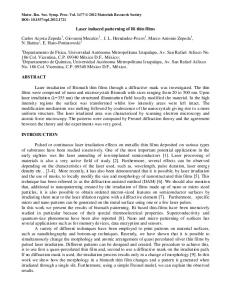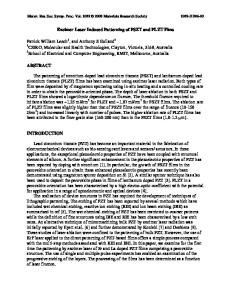Surface Patterning by Laser Induced Localized Chemistry
- PDF / 1,344,784 Bytes
- 6 Pages / 595 x 842 pts (A4) Page_size
- 28 Downloads / 423 Views
Surface Patterning by Laser Induced Localized Chemistry Aurélie Lachish-Zalait1, David Zbaida1, Eugenia Klein2, Michael Elbaum1 1 Materials and Interfaces Dept. and 2Electron Microscopy Unit, The Weizmann Institute of Science, Rehovot 76100, ISRAEL ABSTRACT A method is described for creating microscale-patterned surfaces by direct-write lithography. A tightly focused, low-power infrared laser beam is applied to a homogeneous precursor solution containing soluble reagents. When the laser is focused directly at a glasssolution interface, it initiates the local precipitation of a solid product that attaches firmly to the substrate. Operating the laser momentarily forms isolated spots, while moving the microscope stage or the laser spot draws continuous lines. The method has been demonstrated for metallic silver and gold, for oxidized copper, and for molybdenum disulfide, suggesting a broad generality in the range of suitable materials. Silver patterns were further modified by chemical reactions. Their morphology and physical properties can be altered during deposition by the use of capping agents, which may provide a handle for further functionalization. INTRODUCTION In this work we describe a chemical method for generating microscale-patterned surfaces by applying a tightly focused infrared (830nm) laser beam, in a configuration similar to optical tweezers [1], directly onto a homogeneous precursor solution containing soluble reagents. In practice, the solution is enclosed by a glass slide and cover slip separated by wax spacers. The laser is introduced to the optical path and focused by the imaging objective of a microscope. The laser radiation passes through the glass slip and strikes the solution at the interface, inducing the chemical reaction to start and propagate. Importantly, the reaction takes place only if the laser is focused directly at the glass-solution interface. Defocused light or focusing within the solution has no apparent effect. The reaction volume is thus confined to the optical focus of the laser. The product deposits as a solid, usually with a great liberation of heat, and attaches firmly to the surface. Operating the laser momentarily forms isolated spots, while moving the microscope stage or the laser spot in the x-y plane draws continuous lines. The change from deposition of one material to another is achieved simply by exchanging precursor solutions in the sample cell. Furthermore, the deposits can be modified both during and after synthesis.
EXPERIMENTAL The following solutions were subjected to laser irradiation to form Ag, Au, CuO and MoS2 patterns: Diamminesilver hydroxide (Ag(NH3)2OH) in ammonium hydroxide solution (2.5%) [2]; sodium tetrachloroaurate (NaAuCl4) in basic sodium carbonate aqueous solution (pH 8); Diamminecopper hydroxide solution (Cu(NH3)2OH) in ammonium hydroxide solution (2.5%) [2]; Ammoniumtetrathiomolybdate (50mM) aqueous solution. The solutions were passed through a 0.2µm filter and injected to the sample cell consisted of a long cover D9.20.1
slip (22x40 mm, #1.5
Data Loading...








